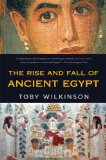Summary | Excerpt | Reviews | Beyond the Book | Readalikes | Genres & Themes | Author Bio

Critics' Opinion:
Readers' Opinion:
First Published:
Mar 2011, 656 pages
Paperback:
Jan 2013, 656 pages
 Book Reviewed by:
Book Reviewed by:
Kevin Bartolotta
Buy This Book
The purpose of the standing stones and the "calendar circle" seems to have been to predict the arrival of the all-important rains that fell shortly after the summer solstice. When the rains arrived, the community celebrated by slaughtering some of their precious cattle as a sacrifice of thanks, and burying the animals in graves marked on the ground with large, flat stones. Under one such mound, archaeologists found not a cattle burial but a huge sandstone monolith that had been carefully shaped and dressed to resemble a cow. Dated, like the calendar circle, to the early fifth millennium b.c., it is the earliest known monumental sculpture from Egypt. Here are to be found the origins of pharaonic stone carving-in the prehistoric Western Desert, among wandering cattle herders, a millennium and more before the beginning of the First Dynasty. Archaeologists have been forced to rethink their theories of Egypt's origins.
On the other side of Egypt, in the Eastern Desert, equally remarkable discoveries have been made, confirming the impression that the arid lands bordering the Nile Valley were the crucible of ancient Egyptian civilization. Thousands of rock pictures pecked into the sandstone cliffs dot the dry valleys (known as wadis) that crisscross the hilly terrain between the Nile and the Red Sea hills. At some locations, usually associated with natural shelters, overhangs, or caves, there are great concentrations of pictures. One such tableau, by a dried-up plunge pool in the Wadi Umm Salam, has been likened to the Sistine Chapel. Its images constitute some of the earliest sacred art from Egypt, prefiguring the classic imagery of pharaonic religion by as much as a thousand years. Like their sculpture-loving counterparts at Nabta Playa, the prehistoric artists of the Eastern Desert seem also to have been cattle herders, and pictures of their livestock-and the wild animals they hunted out on the savanna-feature heavily in their compositions. But instead of using megaliths to signify their deepest beliefs, they exploited the smooth cliff faces offered by their own environment, turning them into canvases for religious expression. Gods traveling in sacred boats, and ritual hunts of wild animals, are key themes in the pharaonic iconography first attested in the Eastern Desert rock art. The inaccessible and inhospitable character of the region today belies its pivotal role in the rise of ancient Egypt.
Gathering speed
Ongoing survey and excavation at sites across the Western and Eastern deserts is revealing a pattern of close interaction between desert and valley peoples in prehistory. Rather unexpectedly, the semi- nomadic cattle herders who roamed across the prehistoric savanna seem to have been more advanced than their valley-dwelling contemporaries. But in a lesson for our own times, the cattle herders' vibrant way of life was made extinct by environmental change. Beginning in about 5000, the climate of northeast Africa began to undergo a marked shift. The once predictable summer rains that for millennia had provided cattle herders with seasonal pasture away from the Nile became steadily less reliable. Over a period of a few centuries, the rain belt moved progressively southward. (Today the rains, when they fall at all, fall over the highlands of Ethiopia.) The savannas to the east and west of the Nile began to dry out and turn to desert. After little more than a few generations, the desiccated land was no longer able to support thirsty herds of cattle. For the herders, the alternative to starvation was migration-to the only permanent water source in the region, the Nile Valley.
Here, the earliest settled communities, along the edge of the floodplain, had been established in the early fifth millennium b.c., broadly contemporary with the megalith builders of Nabta Playa. Like the cattle herders, the valley dwellers had also been practicing agriculture, but in contrast to the seasonality of rainfall in the arid regions, the regime of the Nile had made it possible to grow crops year-round. This would have given the valley dwellers the incentive and the wherewithal to occupy their villages on a permanent basis. The way of life the valley dwellers developed is known to Egyptologists as the Badarian culture, after the site of el-Badari, where this lifestyle was first recorded. The local vicinity was ideally suited to early habitation, with the juxtaposition of different ecosystems-floodplain and savanna-and excellent links to a wider hinterland. Desert routes led westward to the oases, while a major wadi ran eastward to the Red Sea coast. It was through these avenues that the Badarian way of life was strongly influenced by the early desert cultures.
Excerpted from The Rise and Fall of Ancient Egypt by Toby Wilkinson Copyright © 2011 by Toby Wilkinson. Excerpted by permission of Random House, a division of Random House, Inc. All rights reserved. No part of this excerpt may be reproduced or reprinted without permission in writing from the publisher.





The Flower Sisters
by Michelle Collins Anderson
From the new Fannie Flagg of the Ozarks, a richly-woven story of family, forgiveness, and reinvention.

The House on Biscayne Bay
by Chanel Cleeton
As death stalks a gothic mansion in Miami, the lives of two women intertwine as the past and present collide.

The Funeral Cryer by Wenyan Lu
Debut novelist Wenyan Lu brings us this witty yet profound story about one woman's midlife reawakening in contemporary rural China.
Your guide toexceptional books
BookBrowse seeks out and recommends the best in contemporary fiction and nonfiction—books that not only engage and entertain but also deepen our understanding of ourselves and the world around us.